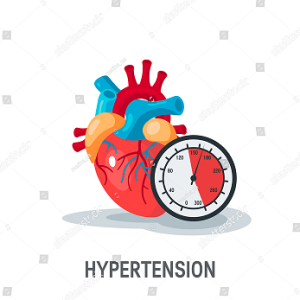Introduction ;
Hypertension (high blood pressure) is the most common primary diagnosis in the United States. It affects approximately 86 million adults (≥20 years) in the United States and is a major risk factor for stroke, myocardial infarction, vascular disease, and chronic kidney disease.

Primary hypertension:
Its a most common type and develops gradually over time .Primary or essential hypertension accounts for 90-95% of adult cases, Exact cause often unclear, may be due to genetics, lifestyle factors, or a combination.
-
The first blood pressure reading is called the systolic blood pressure. The second blood pressure reading is called the diastolic blood pressure.
Secondary Hypertension:
-
- It is Caused by an underlying medical condition.
- It can result from various underlying conditions, including kidney disease, endogenous hormonal disorders, vascular disorders, neurogenic causes, sleep apnea, medication side effects, toxins, hypo- and hyperthyroidism, hyperparathyroidism, acromegaly, and pregnancy-induced hypertension.
Hypertensive Emergencies,
The most common hypertensive emergency involves a rapid, unexplained rise in blood pressure (BP) in patients with chronic essential hypertension. Many patients developing hypertensive emergencies have a history of inadequate hypertensive treatment or an abrupt discontinuation of their medications.
Other causes of hypertensive emergencies encompass the use of recreational drugs, abrupt clonidine withdrawal, post-pheochromocytoma removal, and systemic sclerosis.
White Coat Hypertension,
White coat hypertension is observed in patients with BP levels above the 95th percentile in a physician’s office but who are normotensive outside of this setting.
Diagnosis ;
Hypertension is defined as a systolic blood pressure (SBP) of 140 mm Hg or more, or a diastolic blood pressure (DBP) of 90 mm Hg or more, or the use of antihypertensive medication.
- Medical History:
- The healthcare provider initiates the diagnostic process by obtaining a comprehensive medical history, inquiring about personal and family medical backgrounds, lifestyle habits, and known risk factors such as smoking, obesity, or a sedentary lifestyle.
- Blood Pressure Measurement:
- Diagnosis of hypertension relies on blood pressure readings, typically obtained using a sphygmomanometer (blood pressure cuff).
- Blood pressure is expressed as two numbers: systolic (the higher number) and diastolic (the lower number), with normal blood pressure considered around 120/80 mm Hg.
- Multiple Readings:
- A single high blood pressure reading may not be conclusive for a hypertension diagnosis. Multiple readings taken on different occasions are often necessary to confirm the diagnosis.
- These readings should be obtained under controlled conditions, such as in a healthcare provider’s office or clinic, to minimize factors that could temporarily elevate blood pressure, such as white coat syndrome.
- Diagnostic Criteria:
- Hypertension is diagnosed when a person consistently records blood pressure measurements of 130/80 mm Hg or higher on multiple occasions.
- Additional Testing:
- In certain cases, additional tests may be ordered to evaluate the impact of hypertension on organs such as the heart, kidneys, and blood vessels. These tests may include:
- Blood tests to check for organ damage and assess kidney function.
- An Electrocardiogram (ECG or EKG) to evaluate heart function.
- Echocardiogram to assess heart structure and function.
- Ambulatory Blood Pressure Monitoring (ABPM) to monitor blood pressure over a 24-hour period.
- In certain cases, additional tests may be ordered to evaluate the impact of hypertension on organs such as the heart, kidneys, and blood vessels. These tests may include:
- Assessment of Risk Factors:
- The healthcare provider will also assess additional risk factors for cardiovascular disease, including cholesterol levels, diabetes, and lifestyle factors like diet and physical activity.
- Diagnosis Confirmation:
- Once the diagnosis is confirmed, the healthcare provider discusses treatment options, recommends lifestyle changes, and may prescribe medication to lower and manage blood pressure.
As outlined in the Seventh Report of the Joint National Committee on Prevention, Detection, Evaluation, and Treatment of High Blood Pressure (JNC 7), the classification of blood pressure for adults aged 18 years or older was traditionally categorized as follows :
-
-
-
-
Normal: Systolic blood pressure lower than 120 mm Hg, diastolic blood pressure lower than 80 mm Hg
-
Prehypertension: Systolic blood pressure 120-139 mm Hg, diastolic blood pressure 80-89 mm Hg
-
Stage 1 Hypertension: Systolic blood pressure 140-159 mm Hg, diastolic blood pressure 90-99 mm Hg
-
Stage 2 Hypertension: Systolic blood pressure 160 mm Hg or greater, diastolic blood pressure 100 mm Hg or greater
-
-
-
However, the 2017 American College of Cardiology/American Heart Association (ACC/AHA) guidelines introduced a modification to the classification system, eliminating the category of prehypertension. Instead, it was divided into two levels levels :
-
-
-
Elevated Blood Pressure: Systolic blood pressure between 120 and 129 mm Hg and diastolic blood pressure less than 80 mm Hg
-
-
-
Signs and Symptoms of Hypertension:
- Often referred to as the “silent killer” due to lack of noticeable symptoms.
- -Headaches, especially at the back of the head.
- -Shortness of breath.
- -Nosebleeds.
- -Flushed face.
- -Dizziness.
Lifestyle modifications
JNC 7 provides recommendations for reducing blood pressure and decreasing cardiovascular disease risk through lifestyle modifications. The combination of two or more of these modifications tends to yield greater results:
- Weight Loss: Aim for a weight loss of approximately 5-20 mm Hg per 10 kg of body weight.
- Alcohol Intake: Limit alcohol consumption to no more than 1 oz (30 mL) of ethanol per day for men or 0.5 oz (15 mL) for women and individuals of lighter weight. This can result in an approximate systolic blood pressure reduction of 2-4 mm Hg.
- Sodium Intake: Reduce sodium intake to no more than 100 mmol/day (equivalent to 2.4 g of sodium or 6 g of sodium chloride). This is associated with an approximate systolic blood pressure reduction of 2-8 mm Hg.
- Dietary Potassium: Maintain an adequate intake of dietary potassium, approximately 90 mmol/day.
- Dietary Calcium and Magnesium: Ensure adequate intake of dietary calcium and magnesium for overall health.
- Smoking Cessation: Quit smoking, and reduce intake of dietary saturated fat and cholesterol for overall cardiovascular health.
- Aerobic Exercise: Engage in aerobic exercise for at least 30 minutes daily on most days, resulting in an approximate systolic blood pressure reduction of 4-9 mm Hg
The DASH (Dietary Approaches to Stop Hypertension) diet is a well-regarded approach to managing hypertension. It emphasizes eating nutrient-rich foods such as fruits, vegetables, whole grains, lean proteins, and low-fat dairy while reducing sodium intake. This can help lower blood pressure and promote heart health.
Pharmacologic therapy
If lifestyle modifications prove insufficient to achieve the target blood pressure, there are various drug options available for treating and managing hypertension. The choice of antihypertensive medication depends on factors such as the individual’s race and specific health conditions. Thiazide diuretics, angiotensin-converting enzyme inhibitors (ACEIs) or angiotensin receptor blockers (ARBs), and calcium channel blockers (CCBs) are considered preferred agents in non-black populations. In contrast, CCBs or thiazide diuretics are favored in black hypertensive populations.
It’s important to note that these recommendations do not exclude the use of ACE inhibitors or ARBs in the treatment of black patients or CCBs or diuretics in non-black individuals. Often, a combination of antihypertensive agents is necessary to achieve adequate blood pressure control.
.
Precautions for Hypertension:
- Adhere to prescribed medication regimen and follow-up appointments to monitor their blood pressure regularly.
- Limit salt intake to recommended levels.
- Avoid excessive alcohol consumption.
- Manage stress through relaxation techniques and hobbies.
- Engage in regular physical activity, as advised by a healthcare professional.
- Avoid excessive use of caffeine.
Frequently Asked Questions (FAQs);
What is hypertension?
Hypertension, also known as high blood pressure, is a condition where the force of blood pushing against your artery walls is consistently too high.
What are the symptoms of hypertension?
In most cases, there are no symptoms with early hypertension. However, severe hypertension can cause headaches, nosebleeds, fatigue, and blurred vision
What causes hypertension?
The exact cause is often unknown, but risk factors include genetics, age, unhealthy diet, lack of exercise, smoking, excess alcohol, and underlying health conditions.
What are the complications of hypertension?
If untreated, hypertension can lead to serious health problems like heart attack, stroke, kidney failure, and dementia.
How is hypertension diagnosed?
Blood pressure measurement at a doctor's office or through home monitoring is used for diagnosis.
What are the blood pressure ranges for hypertension?
Normal blood pressure is below 120/80 mmHg. Elevated is 120-129/80 mmHg. Stage 1 hypertension is 130-139/80-89 mmHg, and stage 2 is 140/90 mmHg or higher.
How is hypertension treated?
Lifestyle changes like healthy diet, exercise, and weight management are crucial. Additionally, medications may be prescribed to lower blood pressure.
Are there any lifestyle changes I can make to manage hypertension?
Reducing salt intake, eating a balanced diet rich in fruits and vegetables, regular exercise, maintaining a healthy weight, limiting alcohol, and managing stress are all beneficial.
What medications are used to treat hypertension?
Different types of medications exist, and your doctor will determine the best option based on your individual needs.
I have white coat hypertension. What does that mean?
This refers to elevated blood pressure readings only in clinic settings, not at home. Monitoring at home and discussing with your doctor is crucial.
I'm pregnant and have hypertension. What should I do?
Prenatal care and close monitoring by your doctor are essential.










